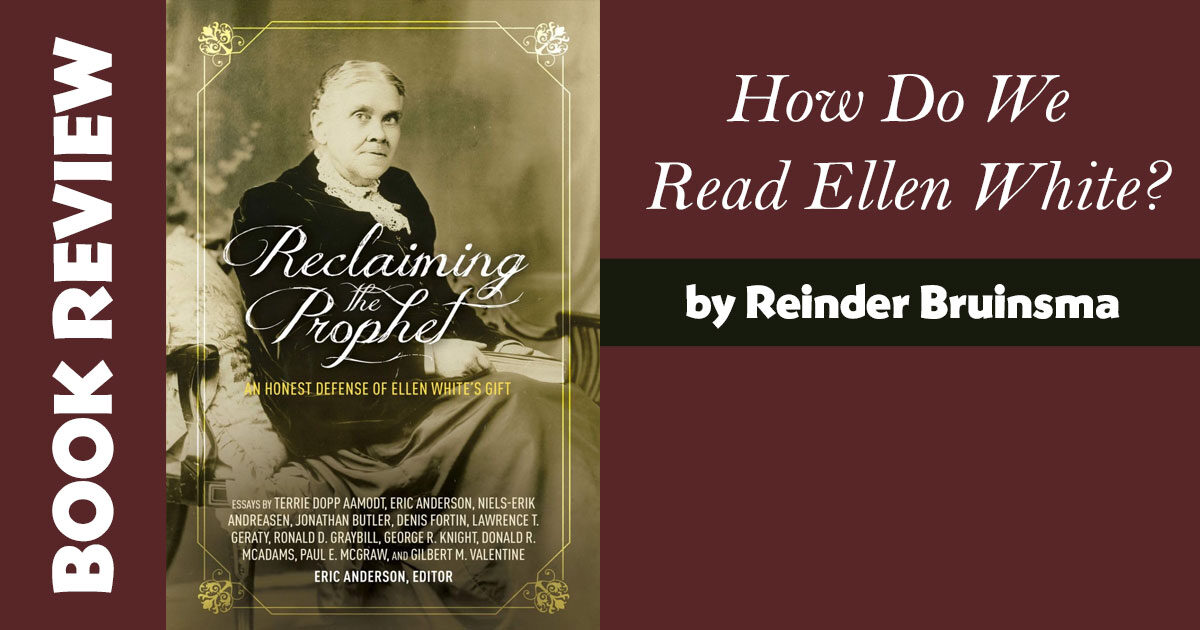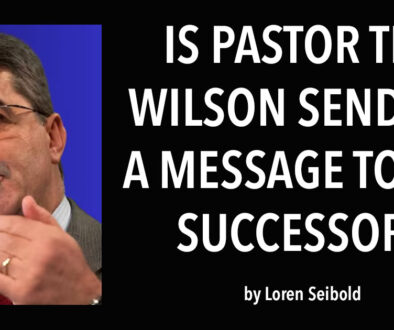Reclaiming the Prophet: How to Read Ellen White
by Reinder Bruinsma | 26 June 2025 |
I first became aware of Reclaiming the Prophet when I saw urgent warning to stay far away from it on the website of the far-right website Fulcrum7. It was clear from the description that the author of the short, ultra-negative piece had not read the book, but that the names of the authors were enough of a reason not to touch it.
I wondered why in the world Fulcrum7 would give publicity to this new book about the person and ministry of Ellen White, as this would only help to make more potential readers aware of its existence. Perhaps they were reassured by the triumphant announcement that the publisher had abruptly stopped the marketing of the book?
But I suspect that a lot of people were like me: it stimulated my interest, and I was determined to get a copy.
Now, about two weeks later, I have read this 180-page “honest defense of Ellen White’s gift” (as reads the subtitle). It was written by eleven prominent Adventist experts in Adventist denominational history, with Eric Anderson, a recently retired director of the Walter C. Utt Center for Adventist History (at Pacific Union College), as the editor.
And, I became aware of a negative assessment of this collection of essays from the Ellen White Estate. (If you want a précis of it, check out this piece from Adventist Today.) The White Estate, which regards itself as the official guardian of the literary legacy of Ellen White, includes some positive remarks about the authors and their work, but concludes that the book is “unbalanced” in its emphasis on the human side of the prophet and her gift. The White Estate people are so unhappy with the overall impact of the book that they “appreciate” that “following recent consultations” the publisher has decided not to “further circulate or reprint the book.”
As a result, after some 300 copies of the book have left the Pacific Press warehouse, no more copies can be ordered. Amazon.com says that the book is “currently unavailable” and it is unknown when “this item will be back in stock.”
I trust that one day soon we will learn what led to the decision to discontinue the sale of this book just weeks after it was launched. Was the statement by the White Estate sufficient to convince Pacific Press’s management to withdraw it? I am not by nature a conspiracist, but it doesn’t seem to me too far-fetched to suppose that the top leadership of the church had a role in this unfortunate development. (Those readers who know how I personally met with a Wilsonian veto when last October I was scheduled to give a lecture at Loma Linda University, will understand why I suspect Ted Wilson’s shadow hovering over it.)
Ellen on the pedestal
Any effort to bring Ellen White down from the pedestal (where she never wanted to be in the first place) threatens a determined strategy of the church’s top leadership to elevate her ministry and her prophetic role. Yet this has become increasingly difficult for them, for they have to ignore historical research and keep it hidden from the people in the pews.
But the current official view of her inspiration seems to me neither biblical nor factually defensible.
We see this Ellen White push most notably in the General Conference’s determination to distribute massive quantities of The Great Controversy on a global scale, and the decision at the recent Annual Council to launch a program of translating and distributing a range of Ellen White books in many different languages. No information was given about the funding of this colossal translation program, but I have no doubt that the money will somehow be found, with some rich donors possibly chipping in a significant portion of the budget.
So it is understandable that Reclaiming the Prophet is seen by the White Estate and the General Conference leaders as a nuisance that creates unrest and stimulates opposition to their grandiose Ellen White projects.
What’s the problem?
Having carefully read the book, I wonder: What is so upsetting about this book that the nuclear option has been chosen? Why remove it from the Adventist Book Center shelves, and from Amazon and other digital bookstores?
Indeed, in Reclaiming the Prophet, many human aspects of Ellen White are highlighted, and for some readers these may be shocking and confusing. But I have found only a few details that I had not already encountered in some other books—in many cases also published by the Pacific Press. In some biographies in the Adventist Pioneers Series, Ellen White’s interaction with early church leaders receives ample attention, and in several instances these books paint a picture of the prophet who was not only imperfect, but who could actually be downright unpleasant. George Knight’s Ellen White’s Afterlife (2019), likewise published by Pacific Press, is outspoken about her human side, and urges the readers to take another look at various aspects of her inspiration and the background of her literary production.
How did these books escape the ecclesial censorship that now so mercilessly hit Reclaiming the Prophet?
Less than two years ago, in October 2023, a group of Ellen White experts met for an informal conference in Angwin, California. They shared the conviction that the ever-increasing polarization in the church concerning Ellen White had to be urgently addressed. They wanted to counter two extreme positions they were seeing all around them: a disinterest and ignorance on the one hand, and an elevation of her status that goes far beyond her own self-understanding and that of most of her contemporaries on the other.
Their common concern: How can we steer the church towards a “proper use” of this gift of God and “reclaim” our prophet by an “honest affirmation of her gift?” (p. 8).
Part 1: Who was Ellen White?
The first section is three essays, by Terrie Dopp Aamodt, Jon Butler, and Gilbert M. Valentine, respectively. Aamodt, the only female member of the group, pictures Ellen White as a woman, i.e., a daughter, a sister, a wife, and a mother. She describes how Ellen’s role as wife and mother often conflicted with her prophetic calling. This in many respects reveals how, despite her calling, she remained an imperfect human being.
Butler shows how the many positive sides of Ellen White were flanked by serious flaws. He traces some major developments in her life and service to the church, and specifically in her career as a writer. Many church members who find her books inspiring are not aware how they were produced—often with a great deal of help from others. It is, Butler says, important to know about these things. Yet he insists that after becoming aware of her flaws as an author, “We do read her texts and still find them inspiring” (p. 39).
I found the third essay perhaps the most informative in this section. Valentine points to Ellen White as a “messenger with a New England style.” Knowing more about the directness of the New England “plain speech,” and realizing that Ellen White came from that region, helps us to understand the rather blunt way in which she often addressed the recipients of her testimonies. Likewise, I was struck by Valentine’s description of her as a “high-maintenance person,” who, especially in her later years, needed an array of people around her in order to comfortable function in her ministry (p. 68).
Part 2: How to read Ellen White
In this second section, Paul E. McGraw, the academic dean at Hong Kong Adventist College, paints Ellen White as a highly effective preacher. He explains how her preaching influenced her style of writing—in particular, when she retells the biblical narratives. Consequently, he says, “her writing tends to be more homiletical than exegetical” (p. 74).
Denis Fortin’s chapter about “Ellen White as a devotional writer” is, in my view, the strongest piece in this collection. He begins with some very incisive remarks about the genesis of her major books, in which he stresses her dependence on other authors and the extensive role of her literary assistants. He reports his research as to how Steps to Christ was put together, and the major role of Marian Davis in this project—a story that also describes many of her other writings.
Fortin suggests that hiding the facts of how the books were assembled is “a form of deception, creating unhealthy expectations in people who lack crucial information” (p. 90). For Fortin, the continuing importance of Ellen White’s legacy is mostly in the devotional value of her writings.
In his essay, the book’s editor, Eric Anderson, highlights an often-overlooked element: the need to use common sense in applying what the prophet wrote in a particular context, back in her days, to events and circumstances in our day and age.
Tomorrow: How to believe in Ellen White
 Reinder Bruinsma lives in the Netherlands with his wife, Aafje. He has served the Adventist Church in various assignments in publishing, education, and church administration on three continents. He still maintains a busy schedule of preaching, teaching, and writing. His essays are collected at http://reinderbruinsma.com/.
Reinder Bruinsma lives in the Netherlands with his wife, Aafje. He has served the Adventist Church in various assignments in publishing, education, and church administration on three continents. He still maintains a busy schedule of preaching, teaching, and writing. His essays are collected at http://reinderbruinsma.com/.
His latest book is Adventists and Catholics: The History of a Turbulent Relationship.




